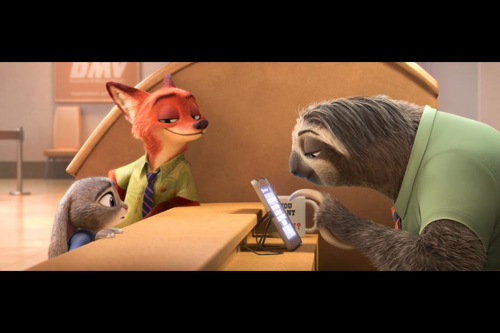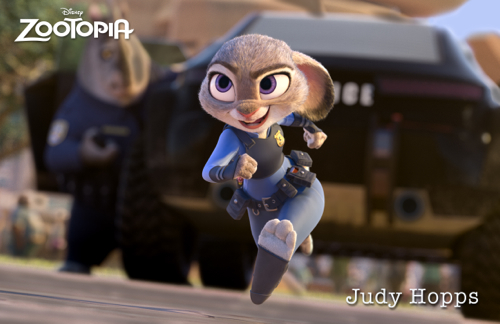Directors Byron Howard and Rich Moore Talk Disney’s “Zootopia”
Hi everyone!
I posted an article about my interview with Jason Bateman and Ginnifer Goodwin from Disney’s Zootopia a few days back, and today I’m sharing more from the roundtable interviews. Our group spoke with Byron Howard and Rich Moore, co-directors on the film at Disney’s Animal Kingdom Lodge. Howard’s last major directing project was Tangled and Moore’s was Wreck-It Ralph – it would have been hard with that talent to have anything less than a major hit, and I do believe Zootopia will be one. While I can’t review it for a couple of more days, the interview touched on a variety of different topics, including some of the more serious undertones in the film. Bullying, prejiduces and being anything you want to be are major points in the film. I believe that Zootopia handles those subjects very well, along with a delicate balance of scary and humorous (I laughed harder at Zootopia than any other film I can remember recently).
Photo Copyright Disney
Zootopia had been in development for about five years, and there was so much for the filmmakers to think about. Like there are 64 species of mammals in the film, all with different – and accurate – fur. There are no birds, reptiles or apes in the film. Apes were not used because they are similar to humans and the filmmakers did not want any particular species to seem too much smarter than any other. And they not only used 64 species of animals, but each animal has human qualities but also specific qualities associated with it. Take Judy Hopps. She is one of the main characters who is the first bunny on the police force. Not only does she walk on two feet, but quivers her nose like a bunny, her ears perk up when she hears something, and she quickly taps her foot when agitated or happy. The elephants serving ice cream in a shop scoop with their trunks, and that is quite a funny scene. And at the DMV (the Department of Mammal Vehicles), the slow workers behind the counters are…sloths. The filmmakers had to create solutions for each animal to live and work in a community together.

Photo Copyright Disney
Howard said they got their “first choices” of all the talent they asked for – Jason Bateman, Ginnifer Goodwin, Shakira, Idris Elba (and all are excellent in the roles). Moore noted that they never ask them to change their voices, that “we cast them for the personalities that they are”. They also look at the chemistry between the actors.
I asked Howard and Moore what the timeline was on making such a movie. We had talked with Moore in 2013, and the crew had already conducted their 18 months of animal research at that time. (I also mentioned that I’d asked Kristin Bell if she’d ever play a sloth back in 2013, and she does in Zootopia). They said the animation process actually starts later in creating the film, not “in earnest” on Zootopia until the end of 2014. Moore said animating “was about 9 months, that’s standard”. Howard continued, “And before that, some CG. CG is way different than 2D, in that you have to build all this stuff up front. So, just to give you an example – that Nick character, Jason Bateman’s character in the movie, from concept drawing to finished, movable animated Nick took one year – for one character. So that includes modeling the character, rigging the character, controls, fur and simulated clothing, color choices and then finally getting him onscreen.”

Photo Copyright Disney
Howard told us that they flipped the protagonist later in the process, and that because of how much work it takes to create one character, “It was a huge thing to do, because people have spent a year of their time building sets for characters that just didn’t exist in the movie anymore. It’s a big ask of the crew to say ‘just trust us’”….and Moore took over and finished the sentence…”we’re trying something new, it seems crazy” (everyone laughed at that point). Howard then picked back up, “Their eyes start to twitch”.
I mentioned at the beginning of the article that Zootopia deals with some serious themes. When asked if that a hard sell when making the film, Moore and Howard said it wasn’t. Howard said, “In fact, we were really embraced by Bob Iger and Alan Horn when they’d see cuts of the movie…it was literally like, ‘thank you for making this”’. Howard continued, “We never started with a political agenda or trying to prove some intellectual point. It all came from the research, where we figured out that mammals are 90% prey animals and 10% predators. We thought…that’s an interesting fact, that if animals evolved, and built this metropolis, did they really leave that mistrust of each other completely behind or does it still lurk under the surface somewhere?”

Photo Copyright Disney
Howard and Moore had to create a film where animals could live together, those who would normally be prey and others who would be predators. And in doing that, they also had to solve the problem that the predators still need meat protein and would normally be eating the prey. So the most popular fast food restaurant in Zootopia is Bug-Burga, where protein can be found. Howard said, “In Bug-Burga, you can get a grasshopper shake, cricket chips, or a cicada burger. And it’s all viable protein. In one scene where Nick is telling Judy that she’ll never be a real cop, you’re going to go home and be a carrot farmer, he takes part of a fence and moves it aside. If you look down by his feet, there are Bug-Burga boxes in the litter on the ground.” It is one of the only places viewers will see the restaurant noted in the film.
Howard said of his animators and crew, “We don’t have to ask them to go to 150%, they do it on their own because they care so much. They like that we have a legacy, a history that’s almost 100 years old.”

.JPG)